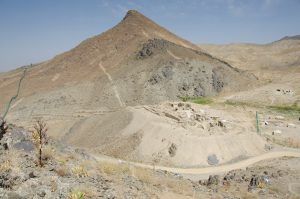After 16 years of delays, last week representatives of Afghanistan’s Taliban government and Chinese engineers broke ground at Mes Aynak, estimated to be the world’s second-largest deposit of copper. The ribbons that were cut were for an access road, a small first step in a project that the Taliban have characterized as “crucial.”
Afghanistan is believed to have significant mineral reserves, largely unexploited due to decades of political instability and war. In total, these resources – which range from copper and iron ore to lithium and other critical minerals – are valued at an estimated $1-3 trillion.
Located around 40 kilometers southeast of Kabul in Logar Province, Mes Aynak is estimated to contain (depending on the source) somewhere between 5.5 and 11.5 million metric tons of high-grade copper ore. Successive Afghan governments – and China – have long hoped to tap into the mine’s potential, but contractual disputes have impeded progress amid security issues, logistical challenges, and government changes.
In November 2007, the China Metallurgical Group Corporation (MCC), a Chinese state-owned conglomerate, outbid competing offers by $1 billion – putting up a $3.4 billon bid for a 30-year lease to develop the mine. The contract, for just under $3 billion, was formally awarded in May 2008 with plans for production to start within five years. Under the original vision, the extracting, smelting, and processing of the raw copper was to occur in Afghanistan. Significant infrastructure projects, such as a power plant and a railway, were also discussed.
In 2013, instead of starting production as originally scheduled, the MCC requested a review of its contract. Plans for the power plant and the rail line were dropped, and soon thereafter the project stalled entirely. Chinese staff reportedly left in 2014 as the war in Afghanistan shifted into a new phase.
In neighboring Pakistan, China began pouring money and attention into the China-Pakistan Economic Corridor (CPEC). Pakistani and Chinese workers became targets of militant groups. Concerns over security have certainly plagued Mes Aynak, too, especially as the Taliban and China began negotiating re-starting the project.
Not long after the Taliban seized control of Kabul in August 2021, the group’s Acting Minister for Mining and Petroleum Shahbuddin Dilawar began pushing for re-engagement with MCC. As the Associated Press reported in March 2022, “Ziad Rashidi, the ministry’s director of foreign relations, approached the consortium made up by MCC, China Metallurgical Group Corporation and Jiangxi Copper Ltd. Dilawar has had two virtual meetings with MCC in the last six months, according to company and ministry officials. He urged them to return to the mine, terms unchanged from the 2008 contract.”
Rashidi told the Associated Press that “Chinese companies see the current situation as ideal for them. There is a lack of international competitors and a lot of support from the government side.”
The Taliban, which had attacked security checkpoints near the mine as recently as 2020, recognized in Mes Aynak – and Chinese capital – an unparalleled financial opportunity.
At the July 24 ribbon-cutting, which marked commencement of work on an access road to the mine, Deputy Prime Minister for Economic Affairs Abdul Ghani Baradar said, “The time wasted in the implementation of the project should be recuperated with speedy work.”
Earlier, as Tolo News reported, a spokesman for the Ministry of Mines and Petroleum said on X, formerly Twitter, “The contracted company has been obligated to start the operations of this world-level major copper mine and its 100 percent process in accordance with the 2008 commitments by the end of this week.”
Taliban officials, however, have moderated that enthusiasm, noting that it will likely take two years before extraction can begin.
Whether Mes Aynak begins producing copper by 2026 or not will rely heavily on several factors, not the least of which is security. But the most likely hiccups will be the same factors that derailed the project in the past: debate over the contract terms and logistical difficulties. A new factor is the Taliban government itself, which certainly views the project – and Chinese investment – as a pathway to international legitimization, if not official recognition.
Chinese Ambassador to Afghanistan Zhao Xing said at the ribbon-cutting that “economic and trade relations between the two countries are becoming increasingly close.” A readout posted by the embassy noted, “The Chinese side is willing to work with Afghan side to smoothly promote the exploitation of Afghan mineral resources while ensuring effective protection of cultural relics, so as to make this project a model of investment cooperation between China and Afghanistan.”
In addition to copper, Mes Aynak is home to the remains of an ancient Buddhist city. Breaking from its Buddha-blasting past, the Taliban have pledged to see the site’s heritage preserved.
The Chinese readout of the ribbon-cutting went on to note that the Afghan side had pledged to “do its utmost to provide security and convenience for the Chinese company.”
































